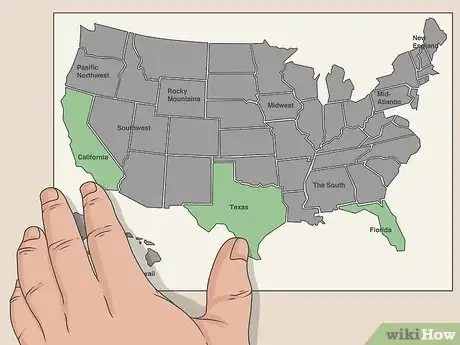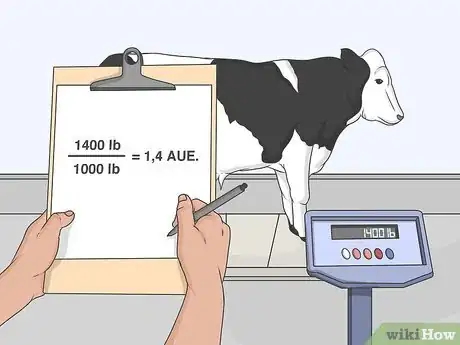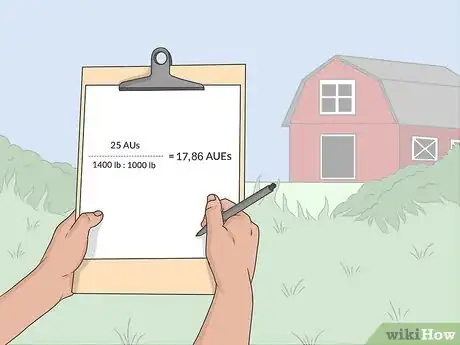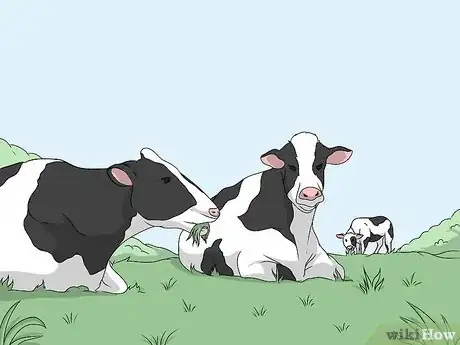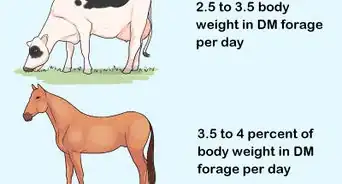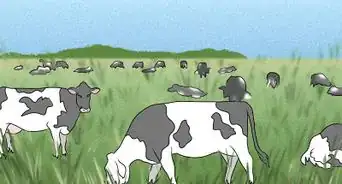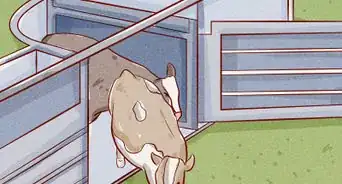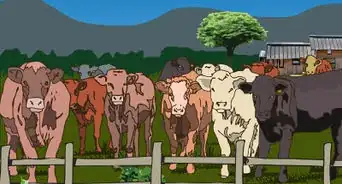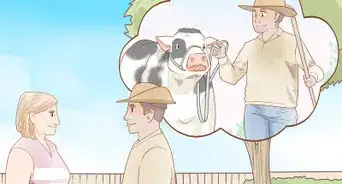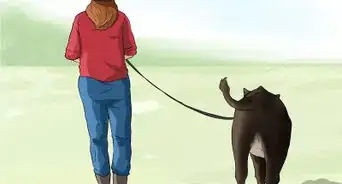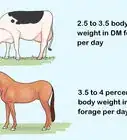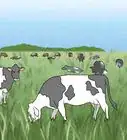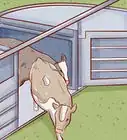This article was co-authored by Karin Lindquist. Karin Lindquist earned a BSc in Agriculture as an Animal Science major from the University of Alberta, Canada. She has over 20 years of experience working with cattle and crops. She's worked for a mixed-practice veterinarian, as a sales representative in a farm supply store, and as a research assistant doing rangeland, soil, and crop research. She currently works as a forage and beef agriculture extension specialist, advising farmers on a variety of issues relating to their cattle and the forages they grow and harvest.
This article has been viewed 15,846 times.
You've got a piece of land that you want to graze. But you have no idea how many animals you should stock on it. The way to figure out how many animals you can put on that pasture takes a little bit of arithmetic, as well as understanding what sort of variables are prone to change.
As with How to Determine How Many Acres of Pasture are Required For Your Cattle, the calculations made give you a general guideline of how many animals you can stock a pasture with for a certain period of time. An example is provided to help you understand how the formulas work so that you can apply them to your own land base.
Steps
-
1Determine the amount of land you have available. This will be the first of one of the most important pieces of information you need in order to find how many cattle you can graze. This number can be in acres or hectares. For example, you may have a 100 acres available for grazing.
- You can even work with as little as one acre. As long as you stick with one unit of measure (acres versus hectares), you are able to work with as much or as little land as you wish.
-
2Calculate the estimated stocking rate for your area. The stocking rate for your location is determined by the amount of forage you have in terms of pounds per acre or kilograms per hectare, the utilization rate expected by the animals based on pasture condition, and how much of that forage is utilized by a standard animal unit for one month.
For more information on how to calculate the stocking rate for your operation, please see How to Calculate Stocking Rates for Your Pastures. For example, you may have a stocking rate of only 1.0 AUM/acre.Advertisement -
3Determine how long you want the cattle to be on the land. Typically this is measured by months, not days. For most North American areas (not including the tropics) a typical grazing season is between 4 to 6 months.
More southern grassland areas, like in California and down into Florida and Texas, are more flexible with being able to graze for 12 months a year. Thus, let's assume you live an area where you are only wanting to graze this 100 acre parcel of land for four months. -
4Determine the number of animal units that can graze on your piece of land. Remember, one Animal Unit (AU) is equal to one 1000 pound (454 kg) cow with or without a calf.
This is the standard unit used in all stocking rate calculations, regardless what animals you actually have.
Thus, the resulting number will be in terms of this standard unit, not the actual average size of the cows to be grazed on your piece of land. The calculation to adjust for animal size is done in the following step.- To determine the number of animal units you can graze on a piece of land us via this formula: Total Animal Units = (Pasture size [acres] x Stocking rate [AUM/acre]) / Length of grazing period (months)
- Therefore, as per our example, Total Animal Units = (100 acres x 1.0 AUM/acre) / 4 months = 25 Animal Units.
- To determine the number of animal units you can graze on a piece of land us via this formula: Total Animal Units = (Pasture size [acres] x Stocking rate [AUM/acre]) / Length of grazing period (months)
-
5Adjust for actual weight of the cows to be grazing the piece of land. Most modern cows are not the same size as the standard animal unit, but rather between 1200 to 1800 pounds.
For this example, if you are grazing cows that weigh an average of 1400 pounds each, then to adjust for animal unit equivalencies by weight, we simply divide the actual average weight of the cows by the weight of the standard animal unit, like so: 1400 lb / 1000 lb = 1.4 AUE. -
6Determine the number of animal unit equivalents to graze your land. Taking the number of animal units calculated from step 4, which was 25 AUs, divide by the AUE calculated in step 5, to get 17,86 AUEs (or around 18 cows) on 100 acres for 4 months.
- To calculate, incorporating step 5: Animal Unit Equivalents = Number of AUs / (Actual animal weight / Animal unit weight); thus AUEs = 25 AUs / (1400 lb / 1000 lb) = 17.86 AUEs.
- In other words, you can have 18 cows (weighing an average of 1400 pounds) grazing your 100-acre parcel of land for four months.
- To calculate, incorporating step 5: Animal Unit Equivalents = Number of AUs / (Actual animal weight / Animal unit weight); thus AUEs = 25 AUs / (1400 lb / 1000 lb) = 17.86 AUEs.
-
7Put the cows out to the pasture to allow them to graze. Monitor pasture conditions and the grazing behavior of the cows.
If they are not getting enough (as in, they do not have their heads down most of the time grazing, but moving around excessively), then it may be time to pull them out and move them to another area to allow the pasture to rest.
It's important to understand that these calculations are merely a guide and an estimation. They are not exact, nor ever will be.
It's up to you, as manager, to pay attention to the resource (forage) the cows need in order to both keep your cows happy, and not cause significant damage to the land.
Community Q&A
-
QuestionI hav 6 acres of pasture in Florida, how many head can graze?
 KarinTop AnswererContact a local agriculture extension agent to get the stocking rate for your area. WikiHow is far too much of a global audience to provide an accurate and localized estimate for your area. Florida, as a state, has quite a lot of variability within state boundaries.
KarinTop AnswererContact a local agriculture extension agent to get the stocking rate for your area. WikiHow is far too much of a global audience to provide an accurate and localized estimate for your area. Florida, as a state, has quite a lot of variability within state boundaries. -
QuestionHow do you determine if pasture is overstocked or understocked?
 KarinTop AnswererIf your pasture is overstocked, you will quickly run out of forage and find you will need to supplement your animals with feed, like hay. Overgrazing will occur. If it is understocked, you will find a lot of grasses will be going to maturity (produce seed) and your animals aren't able to keep up with the grass. However, all this depends on how much moisture you get for your area. If you get a lot of moisture one year versus the other, you will be "chasing grass" that one year versus another year where you may get a drought.
KarinTop AnswererIf your pasture is overstocked, you will quickly run out of forage and find you will need to supplement your animals with feed, like hay. Overgrazing will occur. If it is understocked, you will find a lot of grasses will be going to maturity (produce seed) and your animals aren't able to keep up with the grass. However, all this depends on how much moisture you get for your area. If you get a lot of moisture one year versus the other, you will be "chasing grass" that one year versus another year where you may get a drought.
Warnings
- Overgrazing is a real threat, and can be detrimental not only to the landscape, but to your animals too. Allowing your animals too long on a piece of land can reduce the amount of forage available next year without adequate rest and recovery.⧼thumbs_response⧽
- Stocking rate calculations and calculations like that made above are mere estimates and guidelines, they are by no means accurate nor never changing. Take these with a grain of salt and make sure you monitor your cows and the forage that they are eating regularly.⧼thumbs_response⧽
- Pasture conditions change all the time, just like environmental conditions do. They may change for the worse or for the better, so be prepared to de-stock (or re-stock) if need-be to keep pastures in good shape.
- If feel you have to pull all your cows out of a pasture, then do so because it will be easier on the land when you come back to it in a better year.
⧼thumbs_response⧽
References
- Determining Your Stocking Rate - Utah State University
- Animal Unit Months, Stocking Rate and Carrying Capacity - Manitoba Agriculture


